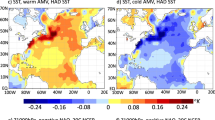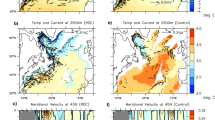Abstract
The stratosphere is connected to tropospheric weather and climate. In particular, extreme stratospheric circulation events are known to exert a dynamical feedback on the troposphere1. However, it is unclear whether the state of the stratosphere also affects the ocean and its circulation. A co-variability of decadal stratospheric flow variations and conditions in the North Atlantic Ocean has been suggested, but such findings are based on short simulations with only one climate model2. Here we assess ocean reanalysis data and find that, over the previous 30 years, the stratosphere and the Atlantic thermohaline circulation experienced low-frequency variations that were similar to each other. Using climate models, we demonstrate that this similarity is consistent with the hypothesis that variations in the sequence of stratospheric circulation anomalies, combined with the persistence of individual anomalies, significantly affect the North Atlantic Ocean. Our analyses identify a previously unknown source for decadal climate variability and suggest that simulations of deep layers of the atmosphere and the ocean are needed for realistic predictions of climate.
This is a preview of subscription content, access via your institution
Access options
Subscribe to this journal
Receive 12 print issues and online access
$259.00 per year
only $21.58 per issue
Buy this article
- Purchase on Springer Link
- Instant access to full article PDF
Prices may be subject to local taxes which are calculated during checkout





Similar content being viewed by others
References
Baldwin, M. P., Thompson, D. W. J., Shuckburgh, E. F., Norton, W. A. & Gillett, N. P. Weather from the stratosphere? Science 301, 317–319 (2003).
Manzini, E., Cagnazzo, C., Fogli, P. G., Bellucci, A. & Müller, W. A. Stratosphere–troposphere coupling at inter-decadal time scales: Implications for the North Atlantic Ocean. Geophys. Res. Lett. 39, L05801 (2012).
Hasselmann, K. Stochastic climate models Part I. Theory. Tellus 28, 473–485 (1976).
Baldwin, M. P. et al. Stratospheric memory and extended-range weather forecasts. Science 301, 636–640 (2003).
Cohen, J., Barlow, M. & Saito, K. Decadal fluctuations in planetary wave forcing modulate global warming in late boreal winter. J. Clim. 22, 4418–4426 (2009).
Gillett, N. P. et al. How linear is the Arctic Oscillation response to greenhouse gases? J. Geophys. Res. 107, 4022 (2002).
Butchart, N., Austin, J., Knight, J. R., Scaife, A. A. & Gallani, M. L. The response of the stratospheric climate to projected changes in the concentrations of well-mixed greenhouse gases from 1992 to 2051. J. Clim. 13, 2142–2159 (2000).
Baldwin, M. P. & Dunkerton, T. J. Stratospheric harbingers of anomalous weather regimes. Science 294, 581–584 (2001).
Hakkinen, S. & Rhines, P. B. Decline of subpolar North Atlantic circulation during the 1990s. Science 304, 555–559 (2004).
Delworth, T. L. & Greatbatch, R. J. Multidecadal thermohaline circulation variability driven by atmospheric surface flux forcing. J. Clim. 13, 1481–1495 (2000).
Eden, C. & Jung, T. North Atlantic interdecadal variability: Oceanic response to the North Atlantic Oscillation (1865–1997). J. Clim. 14, 676–691 (2001).
Wittenberg, A. T. Are historical records sufficient to constrain ENSO simulations? Geophys. Res. Lett. 36, L12702 (2009).
Häkkinen, S. Variability of the simulated meridional heat transport in the North Atlantic for the period 1951–1993. J. Geophys. Res. 104, 10991–11007 (1999).
Lohmann, K., Drange, H. & Bentsen, M. A possible mechanism for the strong weakening of the North Atlantic subpolar gyre in the mid-1990s. Geophys. Res. Lett. 36, L15602 (2009).
Delworth, T., Manabe, S. & Stouffer, R. J. Interdecadal variations of the thermohaline circulation in a coupled ocean–atmosphere model. J. Clim. 6, 1993–2011 (1993).
Msadek, R., Frankignoul, C. & Li, L. Mechanisms of the atmospheric response to North Atlantic multidecadal variability: A model study. Clim. Dynam. 36, 1255–1276 (2011).
Mosedale, T. J., Stephenson, D. B., Collins, M. & Mills, T. C. Granger causality of coupled climate processes: Ocean feedback on the North Atlantic oscillation. J. Clim. 19, 1182–1194 (2006).
Cohen, J., Barlow, M., Kushner, P. J. & Saito, K. Stratosphere–troposphere coupling and links with Eurasian land surface variability. J. Clim. 20, 5335–5343 (2007).
Ottera, O. H., Bentsen, M., Drange, H. & Suo, L. External forcing as a metronome for Atlantic multidecadal variability. Nature Geosci. 3, 688–694 (2010).
Ineson, S. et al. Solar forcing of winter climate variability in the Northern Hemisphere. Nature Geosci. 4, 753–757 (2011).
Scaife, A. A., Knight, J. R., Vallis, G. K. & Folland, C. K. A stratospheric influence on the winter NAO and North Atlantic surface climate. Geophys. Res. Lett. 32, L18715 (2005).
Plumb, R. A. & Semeniuk, K. Downward migration of extratropical zonal wind anomalies. J. Geophys. Res. 108, 4223 (2003).
Hakkinen, S., Rhines, P. B. & Worthen, D. L. Atmospheric blocking and Atlantic multidecadal ocean variability. Science 334, 655–659 (2011).
Martius, O., Polvani, L. M. & Davies, H. C. Blocking precursors to stratospheric sudden warming events. Geophys. Res. Lett. 36, L14806 (2009).
Keenlyside, N. S., Latif, M., Jungclaus, J., Kornblueh, L. & Roeckner, E. Advancing decadal-scale climate prediction in the North Atlantic sector. Nature 453, 84–88 (2008).
Smith, D. M. et al. Skilful multi-year predictions of Atlantic hurricane frequency. Nature Geosci. 3, 846–849 (2010).
Mehta, V. et al. Decadal climate predictability and prediction: Where are we? Bull. Am. Meteorol. Soc. 92, 637–640 (2011).
Reichler, T. & Kim, J. How well do coupled models simulate today’s climate? Bull. Am. Meteorol. Soc. 89, 303–311 (2008).
Delworth, T. L. & Mann, M. E. Observed and simulated multidecadal variability in the Northern Hemisphere. Clim. Dynam. 16, 661–676 (2000).
Schlesinger, M. E. & Ramankutty, N. An oscillation in the global climate system of period 65–70 years. Nature 367, 723–726 (1994).
Gerber, E. P. et al. Stratosphere–troposphere coupling and annular mode variability in chemistry-climate models. J. Geophys. Res. 115, D00M06 (2010).
Acknowledgements
We thank T. Delworth, P. Staten and C. Strong for their comments on an earlier version of this work. We thank the Geophysical Fluid Dynamics Laboratory for making the CM2.1 simulation data available to us. We acknowledge the World Climate Research Programm’s Working Group on Coupled Modelling, which is responsible for CMIP, and we thank the climate modelling groups for producing and making available their model output. For CMIP, the US Department of Energy’s Program for Climate Model Diagnosis and Intercomparison provides coordinating support and led development of software infrastructure in partnership with the Global Organization for Earth System Science Portals. This research used resources of the National Energy Research Scientific Computing Center, which is supported by the Office of Science of the US Department of Energy under Contract No. DE-AC02-05CH11231. T.R. and J.K. were supported by the University of Utah. E.M. and J.K. are grateful for partial funding by the European Commission’s 7th Framework Programme, under GA 226520, COMBINE project. Provision of computer infrastructure by the Center for High Performance Computing at the University of Utah is gratefully acknowledged.
Author information
Authors and Affiliations
Contributions
T.R. designed the research and wrote the manuscript. J. Kim carried out the analysis. All authors contributed to the interpretations of the results and the discussion of the manuscript.
Corresponding author
Ethics declarations
Competing interests
The authors declare no competing financial interests.
Supplementary information
Supplementary Information
Supplementary Information (PDF 1867 kb)
Rights and permissions
About this article
Cite this article
Reichler, T., Kim, J., Manzini, E. et al. A stratospheric connection to Atlantic climate variability. Nature Geosci 5, 783–787 (2012). https://doi.org/10.1038/ngeo1586
Received:
Accepted:
Published:
Issue Date:
DOI: https://doi.org/10.1038/ngeo1586
This article is cited by
-
Downward propagation of the weak stratospheric polar vortex events: the role of the surface arctic oscillation and the quasi-biennial oscillation
Climate Dynamics (2024)
-
Atmospheric trends explained by changes in frequency of short-term circulation patterns
Communications Earth & Environment (2023)
-
Coupled stratosphere-troposphere-Atlantic multidecadal oscillation and its importance for near-future climate projection
npj Climate and Atmospheric Science (2022)
-
Surface ocean current variations in the North Pacific related to Arctic stratospheric ozone
Climate Dynamics (2022)
-
Influence of tropical convective enhancement in Pacific on the trend of stratospheric sudden warmings in Northern Hemisphere
Climate Dynamics (2022)



